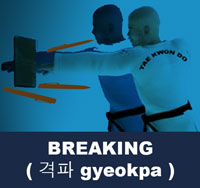Taekwondo 태권도Taekwondo Preschool
When you reach senior belt you are expected to guide the junior belts when they are beginning Taekwondo such as showing by example. To advance from one rank to the next, students typically complete promotion tests in which they demonstrate their proficiency in the various aspects of the art before a panel of judges or their teacher. View Taekwondo belt levels »

Breaking
( 격파 gyeokpa )
Breaking ( 격파 gyeokpa ) is the discipline of destroying inanimate objects such as wooden boards, baseball bats, ice blocks or cement bricks and is a feature common to martial arts including taekwondo. In taekwondo breaking competitions, the idea is to demonstrate power, speed and technique. The preferred object is commonly wooden boards of varying thicknesses, advanced students break several boards stacked one on top of the other.
In taekwondo, the hardness of the object to be broken is usually subjugated to the difficulty of the technique to be employed. Thus various body parts are used, such as the ridge of the hand ( 손날등 sonnal-deung ), the knuckles or even the fingertips. Headbutts, knee strikes, elbow strikes and various parts of the foot are also used to break boards. A single board or stack of boards may be broken or, alternatively, a series of boards may be broken in a pre-set sequence utilizing a variety of strikes. Advanced competitors may even break several boards in a single jump with multiple kicks before landing.
In International Taekwondo Federation (ITF) sparring competitions, using maximum force is not allowed. Furthermore, at advanced levels it would be seriously injurious and possibly fatal. Breaking boards or bricks is therefore the only safe way to test the real power of any martial arts technique (except with fairly high-tech scientific equipment). Taekwondo competition breaking may be roughly divided into two main categories:
- Power Breaking ( 위력격파 ) - The power of a technique is measured by breaking single or multiple stacked boards. Stacked boards are commonly placed on raised supports on the ground.
- Speed Breaking - A single board is held lightly between the fingertips of an assistant, at advanced levels the board is tossed into the air. Regardless of the power of a technique, if the board is not hit with the requisite speed in the correct places it will not break.
Starting with coloured belts taekwondo students must learn breaking. As they progress through the ranks, the breaks they perform increase in difficulty as do the number of boards. As time goes on, the taekwondo student's hands and bones become accustomed to breaking boards - repeated practice hardens bones, skin and tendons. Wolff's law states that the human skeleton will adapt to the stress it is put under, therefore the bones actually become stronger as a taekwondo student advances in his martial arts career.
Wooden boards are the most common breaking item in most martial arts. Individual boards used may range from nominal sizes as small as 6"x12"x1" to as large as 12"x12"x1" (a board with a nominal width of 1" has an actual width of 3/4"). The typical adult testing board is approximately 10"x12"x1". Children may use narrower and thinner boards with 4 and 5 year olds sometimes breaking boards as small as 4"x12"x1/2". Although some boards are also plastic and can change difficulty with every different board.
The grain of the board must be cut so as to be parallel with the striking hand.

Training Safety Precautions
Starting with coloured belts taekwondo students must learn Breaking ( 격파 gyeokpa ). As they progress through the ranks, the breaks they perform increase in difficulty as do the number of boards. Wooden boards are the most common breaking item in most martial arts.
There are safety concerns with taekwondo breaking ( 격파 gyeokpa ), so one should seek out a certified Master Instructor ( 사범님 sabeomnim ). There are many small bones of the foot ( 발 bal ) and hand ( 손 son ) which need to be very carefully and slowly conditioned for safety. Repeated damage to the extensor capsules of the knuckles can lead to long term problems with dexterity.
* Please see a certified Master Instructor ( 사범님 sabeomnim ) for training. Proper guidance and instructions are needed to ensure safe training.

Related Articles
Breaking ( 격파 gyeokpa ) is the discipline of destroying inanimate objects such as wooden boards, baseball bats, large ice blocks or cement bricks. The preferred object is commonly wooden boards of varying thicknesses, advanced students break several boards stacked one on top of the other. View Breaking ( 격파 gyeokpa ) »
Risk of injury can be reduced by completing an effective warm up consisting of a heart raiser to get your pulse up, followed by sport specific dynamic stretches (stretches whilst moving). Please follow the guidance of a certified Master Instructor or trainer when doing sports related activities. Depending on the intensity of the exercise, cooling down can involve a slow jog or walk, or with lower intensities, stretching can be used. Cooling down allows the heart rate to return to its resting rate. View more information on Warming Up and Cooling Down ».
This article uses material from the Wikipedia articles "Warming Up" and "Cooling Down", which is released under the Creative Commons Attribution-Share-Alike License 3.0.
RESOURCES
This article uses material from the Wikipedia articles "List of Taekwondo Techniques Breaking" and "Breaking (Martial Arts)" which is released under the Creative Commons Attribution-Share-Alike License 3.0.



















